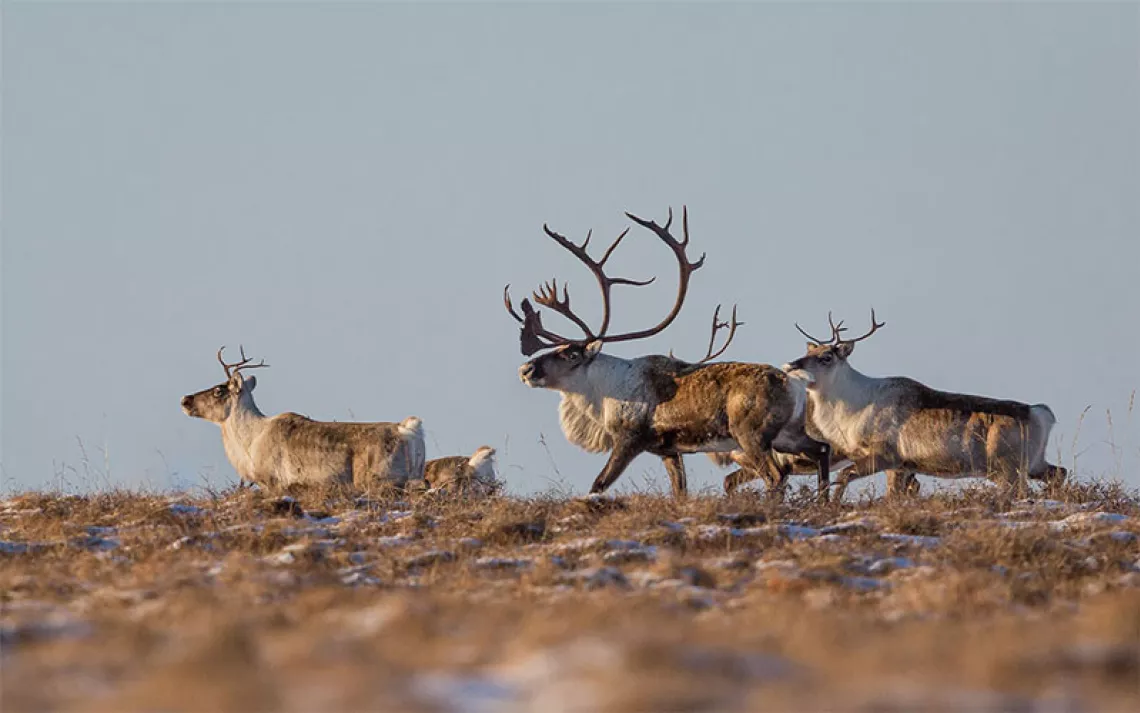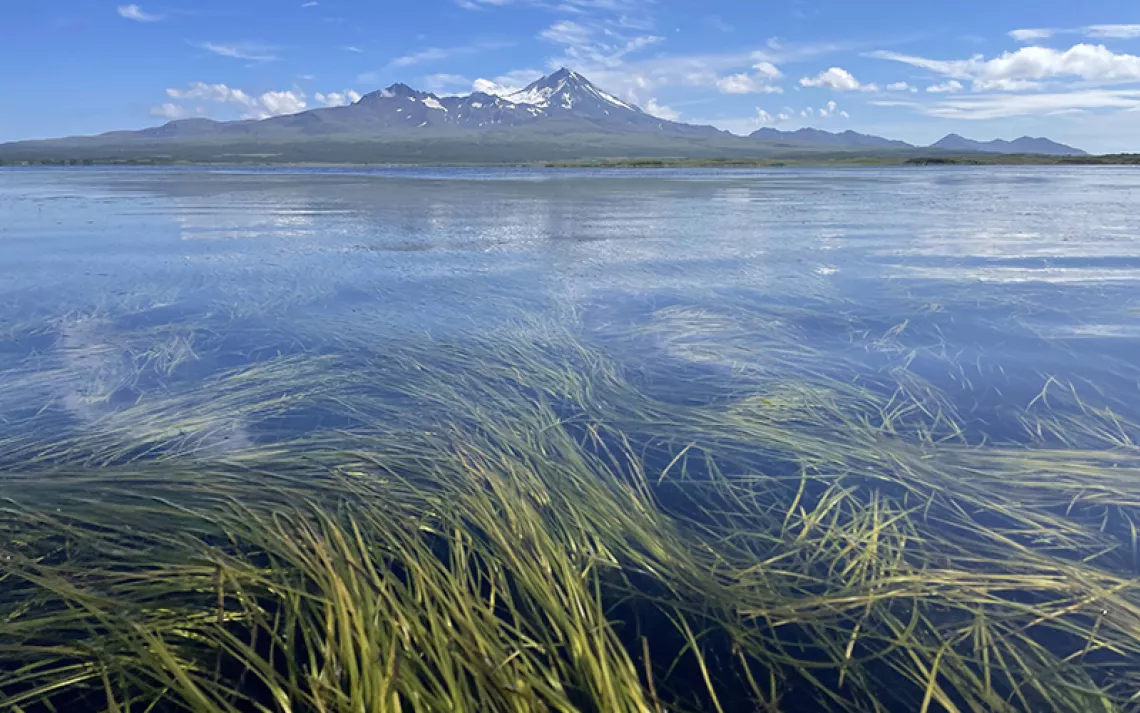Tongass National Forest: Remains of the Rainforest
Reckoning the loss of old growth in Alaska

Tongass National Forest | Photo courtesy US Forest Service
Searching for ancient trees, I wade through the dew-drenched foliage of southeast Alaska's Tongass National Forest. I grab the strong branches of chest-high blueberry bushes and hoist myself up a steep slope. My foot slips,and I almost tumble off the edge of an eight-foot-deep depression camouflaged with moss and ferns. It's impossible to see where I walk since my boots disappear with every step into the tangle of green. Bones of bears, deer, and other unsuspecting creatures have been found in sinkholes in this soggy part of the world. I'd hate to have my remains join them. But I'm not complaining; the forest-floor chaos tells me we're in an area perfect for old growth.
"There's a nice pumpkin," one of my hiking companions calls out soon enough. The "pumpkin" is the bulbous trunk of an enormous Sitka spruce. The tree is a doozy--a few centuries old. Ancient in my eyes, it's just approaching midlife. Giants like these can live for 600 years. As we climb, the maze of trees, ferns, and blueberry bushes gives way to subalpine meadows painted with purple lupine, pale blue gentians, crimson columbine, and yellow arnica. Wild herbs blanket the ground, providing plentiful browse for deer. Limestone outcroppings make nice seats to rest our wobbly legs. From one of these perches we look north across Heceta Island to Sea Otter Sound. It's a perfect view--almost. Heceta Island's 70 square miles are ravaged with clearcuts and scarred with logging roads. There we'll likely find plenty of "ghost trees," the brooding stumps of past pumpkins plucked for timber. It's a pattern being repeated all over the Tongass--a 17-million-acre forest crisscrossed with 4,600 miles of access roads. As much as I love exploring the Tongass's old growth, it's the stumps I've come to investigate, with measuring tape and clipboard.
I'm hiking with conservationists from the Alaska Rainforest Campaign, a coalition of environmental groups that includes the Sierra Club, working to protect the rainforest of southeast Alaska. Like archaeologists seeking clues to a lost culture, we're looking for evidence of once-magnificent forests. So little on-the-ground research has been done in the Tongass--even today, government timber inventories are estimated from aerial surveys, and wildlife studies are few and far between--that it's difficult to know what once flourished here. By measuring the massive, decaying stumps, we can try to construct a picture of the original forest. And by documenting what's been lost, we strengthen the case for protecting what remains.

Sign up to receive Sierra News & Views
Get articles like this one sent directly to your inbox weekly.
With this action you affirm you want to receive Sierra Club communications and may vote on policy designated by the Sierra Club Board.
Forming a 525-mile-long arc of southeast Alaska, the hundreds of islands and the mainland of the Tongass include over 10,000 miles of coastline. The Tongass is the heart of the largest intact temperate rainforest in the world, and some parts are deluged with over 200 inches of rain a year. All that water sculpts soluble carbonate bedrock, such as limestone and marble, into fissures, fluted spires, sinkholes, and caves. This distinctive karst topography creates ideal drainage conditions for growing big trees.
Industrial-scale logging began in earnest here in the 1950s. The federal government subsidized two timber companies to the tune of hundreds of millions of dollars to cut old-growth trees and grind them into pulp. The old giants died so we could have disposable diapers and cellophane-wrapped cigarette packs. In less than 50 years, approximately a half million acres of virgin rainforest were clearcut. "The pumpkins were creamed," says one of my hiking friends.
We follow a gravel logging road. Unlike the old-growth we hiked through earlier, the forest we enter now is dark, silent, and eerie--a good place for ghosts. Clearcut in 1927, the stand today contains plenty of second-growth Sitka spruce, but little else. Since the same-age trees are uniform in size, their crowns create a dense ceiling that robs the forest floor of light. With just a few scraggly ferns and blueberry bushes to choose from, a deer would have a tough time finding a snack. I strain to hear the chatter of a squirrel or the flutter of a bird's wings, but the area is devoid of wildlife. It's like entering a boarded-up house.
It's only a matter of time before we find our ghosts. The hulking stumps dwarf the slender 74-year-old trees. I approach one of the giants and stroke its mossy rotting bark as one might touch the gravestone of a loved one. These decaying monuments testify to a grandeur I'll never experience, and one that the next dozen generations won't witness, for that matter. In the Tongass, it takes at least 250 years for a forest to develop the telltale characteristics of old growth, such as wide variation in sizes and accumulations of dead standing and fallen trees. The 9-foot-high stumps we find were once 500-year-old Sitka spruce. Yet today's foresters debate whether second growth should be harvested at 100 or 200 years. Cementing my tree-hugger status, I apologize to the ghost in front of me and go about my work.
With yellow measuring tape, we plot a one-acre area containing 18 immense stumps. From the center point, we run more tape and create smaller plots. Our study area looks like a giant, bright spiderweb spun on the forest floor. Walking the plot lines, we record the locations of the stumps, measure their diameters, and estimate their heights at the time they were cut down. We tally the results and gape at our figures.
When this acre was an old-growth forest and the stumps were living trees, it contained more than 200,000 board feet of wood. I cringe at describing forests in terms of timber volume, but it's useful in understanding what's been lost and identifying what's left. Today, timberlands in the Tongass contain an average of 27,000 board feet per acre. Stands of 50,000 or more board feet per acre are considered high volume and rare, comprising less than 2 percent of the Tongass timberlands. When my grandfather was young, the stand we measured contained more than four times the wood volume of today's best forests. Moving on, we measure two equally impressive ghost sites. The largest spruce stump we find is a whopping 12 feet across and had soared an estimated 220 feet. The largest known living spruce in Alaska today is 9.5 feet in diameter and 185 feet high.
But there's more to an old-growth forest than big trees. In the Tongass, wind topples individual trees and shapes a diverse forest over centuries of constant decay and regeneration. All ages of trees, from saplings to the old-timers, create a multistoried canopy allowing light to enter the gaps and stimulate new growth. Herbs and shrubs flourish on the forest floor. It may be a hellish place to hike, but there's plenty of food and shelter for wildlife. The Tongass supports brown bear, wolverine, northern goshawk, marbled murrelet, marten, Sitka black-tailed deer, the Alexander Archipelago wolf, and healthy runs of five salmon species.
These animals rely on habitat unfragmented by roads and logging. In March, they gained some ground when a federal judge ordered the U.S. Forest Service to consider whether to designate more wilderness areas in the Tongass, an element the agency had excluded from its 1997 management plan for the forest. But the ruling might not help if the Bush administration turns crucial roadbuilding decisions over to local forest supervisors, a possible result of its reevaluation of Bill Clinton's Roadless Area Conservation Rule, which prohibited roadbuilding on nearly 60 million acres of undeveloped national forest land, including some 10 million Tongass acres.
Aldo Leopold suggested that the first rule of intelligent tinkering is to save all the pieces. After a half-century of clearcutting in the Tongass, we don't even know how many pieces we've lost.
 The Magazine of The Sierra Club
The Magazine of The Sierra Club



